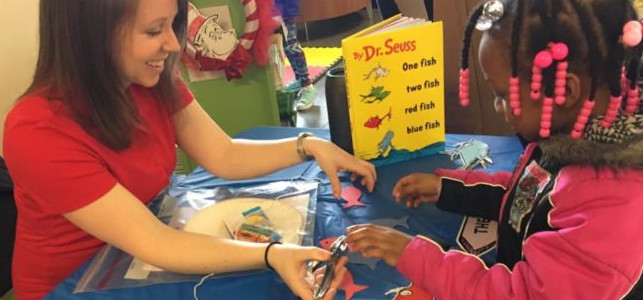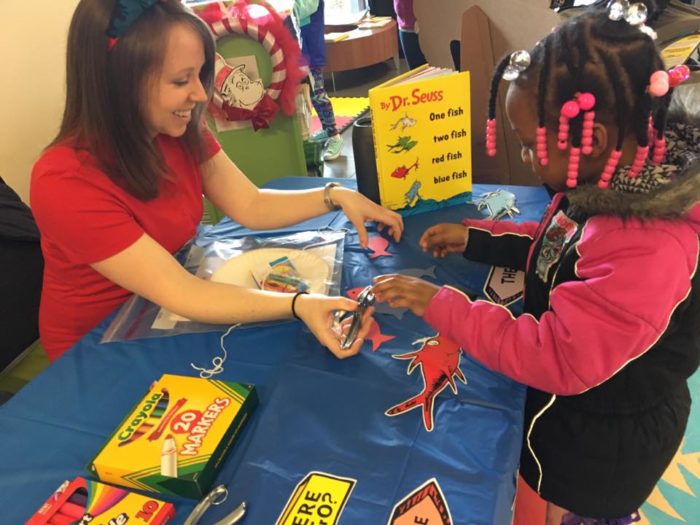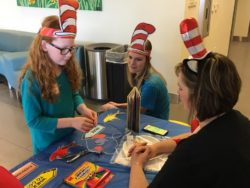
“From there to here, from here to there, funny things are everywhere.” From these opening lines, the Dr. Seuss classic One Fish, Two Fish, Red Fish, Blue Fish brings together simple rhymes, whimsical illustrations and the promise of fun in a book that’s considered a great learning tool for beginning readers.
Describing the book as both “fantastic and fun,” our therapy team recommends reading this type of book often – even daily – with young children. The writing and illustrations are filled with feelings, colors, shapes, numbers, counting, opposites and rhyming pairs, all of which can help children develop language concepts and reading skills. And the book’s entertaining fish characters inspire hands-on activities and active fun that can support a child’s motor skill development in an especially fun way.

In celebration of Dr. Seuss’ birthday (March 2), earlier this month our therapists shared some of the special activities and fun approaches they suggest for using One Fish, Two Fish, Red Fish, Blue Fish to target specific skills. We’ve highlighted some favorites for you below. For both fun and learning, these types of activities are a great addition to your child’s daily reading!
Speech and language activities
Reading at least 15 minutes every day with your child is recommended. The following suggestions are intended to be something you can do at home in addition to 15 minutes of daily reading. The underlined words/phrases are the skills that will be targeted as you complete the suggested activities.
Phonological processing – The term phonology refers to the speech sounds used in a language. Phonological processing (or awareness) is a skill children develop that allows them to recognize the sounds of spoken language (which is critical for learning to read letters and eventually words). Drawing your child’s attention to the print, letters, sounds and the meaning of the text helps a child develop phonological awareness. When working on sounds, focus on one of the following sounds at a time:
Rhyming words – Find all the rhyming words in the story. Can your child think of a nonsense word that sounds like the rhyming pair? Ask your child, “Can you tell me a word that rhymes with ear? (hear, dear/deer, fear). Can you find it in the book?” Point out the letters that are the same and different and talk about the different letters and sounds with your child. A rhyming page, like Seussville.com’s Rhyming Fun Has Just Begun, lists several options for rhyming words.
Syllables – Look for words in the book and count the number of syllables. This helps a child learn about the syllables within a word. Ask your child, “How many syllables are in the words, “Everywhere?” (3), “Hello?” (2) or “Yink” (1).
Initial sounds – Talk about initial sounds (the beginning sound of a word) as you flip through pages of the book. Ask your child questions like, “What is the first sound that you hear in Zans?” or try making it a game: “If I have the word, run, and I take away the /r/ sound and add a /f/ sound, what word would it be?” (“Fun!”)
Metalinguistic concept knowledge: Helping children learn that words can have multiple meanings is important for language comprehension and reading. As children experience the different meanings of words, they eventually become accustomed to the need to figure out a word or sentence’s appropriate meaning. Word play, and even riddles, can help reinforce that there are multiple meanings in words/sentences (called the “metalinguistic concept.”) Opposites are an exciting way to play with words and having children identify opposites can help them learn new meanings. Check out this “finding opposites” Old Fish/New Fish activity for inspiration, or complete it with your child. Can your child find the “opposite matches” to the words? Read the words to your child, point out letters in the words, and model and use these words in everyday activities to reinforce their meanings. Ask your child questions like, “What makes you sad? What makes you glad? When can we be loud? When should we be quiet?”
Verbal expression: There are many different fish in the sea, which makes everyone extra special. Have your child decorate a simple fish graphic to create their own unique fish. (Seussville.com has a Dr. Seuss-style graphic that works well for this.) Talk about the characteristics of your child’s fish together. Commenting and saying things such as, “Wow – I really like that color!” or “That is a super silly face you put on your fish!” models to them how to verbally communicate thoughts and opinions.
Fine motor skill activities
Fine motor skills involve using the small muscles in the hands for tasks like using tools and manipulating objects. These are important foundational skills for learning to do things like hold a pencil correctly, zip a coat, button a shirt and tie shoes. Making a festive fish necklace is a creative way to bring the book to life while also working on these skills!
Red Fish, Blue Fish necklace
Cut fish shapes (approximately 2×3 inches in size) out of red and blue card stock or construction paper. Have your child help cut out the fish if they are able to do so. With scissors, be sure they put their thumb in the top scissor loop and their index and middle fingers in the bottom scissor loop. Remind them to keep their thumb pointed up to the sky! Encourage them to use their helper hand to move the paper too.
Punch a hole at the top of each fish, having your child help squeeze the hole puncher to work on strengthening those little hands. Then, measure a piece of yarn long enough to make a necklace and if they are able, have your child use scissors to cut the piece.
 Next, have them use BOTH hands to string (or help string) the cardstock fish cutouts on to the necklace in a red/blue pattern. Be sure they hold the string in between their thumb and pointer finger – this is called a “pincer grasp” and is an important fine motor skill! If the yarn is difficult to manipulate, try wrapping a bit of tape around the end (like the tip of a shoelace) to give little fingers something more stable to hold on to. Once their design is complete, tie the ends of the string together to complete the necklace.
Next, have them use BOTH hands to string (or help string) the cardstock fish cutouts on to the necklace in a red/blue pattern. Be sure they hold the string in between their thumb and pointer finger – this is called a “pincer grasp” and is an important fine motor skill! If the yarn is difficult to manipulate, try wrapping a bit of tape around the end (like the tip of a shoelace) to give little fingers something more stable to hold on to. Once their design is complete, tie the ends of the string together to complete the necklace.
Note: If you’d like to add more opportunities for fine motor development to the project, your child can peel and place stickers to decorate the fish (using that pincer grasp from earlier!) or use a crayon to add color and details. Encourage your child to hold the crayon with their thumb, index and middle fingers and keep their pinky and ring fingers still and curled into their hand. If they’re having trouble keeping fingers separated, break crayons into smaller pieces (1-2 inches long) to make holding with three fingers easier.
Safety tip: Always supervise children closely when they are working with paint, glue, scissors and other craft supplies.
Gross motor skill activities
Gross motor skills involve coordination and strength of the large muscle groups throughout the body. These skills are important for being able to get around safely in a child’s environment – being able to play on the playground or walk up and down stairs, for example – and they include skills such as running, jumping, skipping and hopping. Before or after reading time, have your child try swimming on their belly “like a fish swimming in water.” This helps build the muscles in their trunk, which are important for posture and help with balance. Also, have your child try the following strength and balance activities using red Swedish fish, paper fish cutouts or toy fish for some skill-building “Red Fish” themed fun:
Fish balance – Practice standing on one leg for the number of seconds equal to the number of Swedish fish on a plate. So, if they pick three fish, they should stand for three seconds.
Fish carry – Have your child balance a paper plate on their head (with fish on the plate) and try to keep the fish on the plate while walking forward.
Fishing rod – Let them try to “catch fish” by picking the fish up off the ground while standing on one leg. Encourage them to keep their balance and see how many fish they can catch without falling down!
Ice fishing – Have your child put each foot on a paper plate and glide across the floor. Be sure they take big, sweeping steps like they’re ice skating – and make sure they keep their feet on the plates! Make it in to a race by timing how long it takes to “skate” out to pick up fish placed on the ground.
If you are concerned about a child’s verbal or motor skills, our therapy team can be a great resource. They can assess a child’s skills and suggest strategies, activities and/or therapy programs that may help. Learn more about what a child should be doing at specific ages. For more about our services and how to schedule an appointment, visit our Therapy Services page.
For more ideas from our specialists for reading fun and learning:
Reading aloud with little ones
Information contributed by Beth Wise, speech-language pathologist, Glen Allen Therapy Center; Jessica Wise, occupational therapist, Brook Road Therapy Center and Elise Roache, physical therapist, Glen Allen/ Bon Air Therapy Centers
